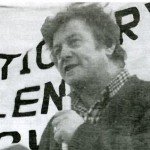
By late 1969 the Irish Republican Army (IRA) was beset by internal divisions and factionalism. A growing number of IRA volunteers had become dissatisfied with the organisation’s leaders and strategy. Much of this dissatisfaction stemmed from a shift in the IRA’s tactics during the 1960s. Under Cathal Goulding and his supporters the IRA embraced Marxist-socialist ideas, becoming more focused on political activism and less concerned with paramilitary action. These divisions over strategy intensified during the August 1969 unrest in Derry, when the IRA was unable to deploy volunteers and arms to support Catholics under attack from Loyalist gangs. Many young radicals were appalled by the IRA’s failure to protect Catholic communities, traditionally one the core principles of the IRA. After a failed attempt to displace IRA leaders, these men formed their own breakaway leadership group called the Provisional Army Council (December 1969). Over the weeks that followed, dozens of IRA members gravitated to this new faction, which became the Provisional IRA. Those who remained under Goulding’s leadership became known as the Official IRA.
Official IRA strategy
The Official IRA remained the larger of the two factions after the split. This changed in early 1972 when the fatal shooting of 14 civilians by British soldiers in Derry triggered a surge in recruiting for the Provisional IRA. During the early 1970s, the Official IRA remained under the leadership of neo-Marxists like Cathal Goulding. While the Official IRA maintained its socialist position and opposition to an all-out war with British troops, the deteriorating situation in Northern Ireland did produce a shift in its tactics. Its volunteers increased military activities in 1970, though their priority was the defence of Catholic civilians, rather than attacks on British security forces. Its commanders also sought out, accumulated and stored weapons, something it had done little of during the 1960s. Many of these weapons came from existing caches, though some sources claim the Official IRA received small arms and explosives from the Soviet Union. Several Official IRA volunteers engaged in running gun battles with British soldiers during the Falls Road curfew (July 1970). The Official IRA also resisted other incursions into Catholic areas.

By 1971 the Official IRA was in a position to escalate military operations. In August 1971 British soldiers launched Operation Demetrius, arresting and interning suspected paramilitary volunteers. Several volunteers defended the Markets area of Belfast from British soldiers, allowing many others to escape. In December that year, Official IRA volunteers assassinated a Unionist politician, John Barnhill, at his home in Strabane, County Tyrone. The ‘Officials’ carried out their most significant operation in February 1972, when they detonated a large car bomb at an army base in Aldershot, England. The bomb was intended for British paratroopers, in retaliation for Bloody Sunday. Instead, it killed five female kitchen workers, an elderly gardener and a Catholic chaplain. In May 1972 the Official IRA kidnapped, interrogated and executed William Best, a 19-year-old British soldier. It later emerged that Best was a Catholic visiting his family in Derry.
The Aldershot bombing and Best’s murder proved embarrassing and damaging for the organisation. Its leaders, never fully keen on a military campaign, contemplated bringing it to an end. On May 29th 1972 the Official IRA declared a conditional ceasefire. The group would carry out occasional attacks on British troops, security forces and Loyalists, though these were usually defensive or retaliatory. Many of its ranking members, including Cathal Goulding, became more involved in Official Sinn Fein, the group’s political wing. In 1982 Official Sinn Fein became the Workers’ Party of Ireland.

1. The Official IRA and the Irish National Liberation Army were both Republican paramilitary groups active in Northern Ireland during the Troubles.
2. The Official IRA was led by Cathal Goulding. It remained the largest of the two IRA factions after the December 1969 and favoured socialist political activism over paramilitary violence.
3. Official IRA paramilitary activity did increase during the Troubles, particularly after Bloody Sunday. But tactical errors such as the Aldershot bombing led to a ceasefire in May 1972.
4. The INLA, an Official IRA breakaway group opposed to the 1972 ceasefire, was formed in December 1974 by around 80 militant Republicans, led by Seamus Costello.
5. Though not as prominent as the Provisional IRA, the Official IRA, the INLA and the IPLO (a splinter group of the INLA) were responsible for hundreds of deaths during the Troubles. Many of these were civilians or Republicans from other groups, killed in internecine feuds.
© Alpha History 2018. Content on this page may not be republished or distributed without our express permission. For more information please refer to our Terms of Use.
This page was written by Rebekah Poole and Jennifer Llewellyn. To reference this page, use the following citation:
R. Poole and J. Llewellyn, “The Official IRA”, Alpha History, accessed [today’s date], https://alphahistory.com/northernireland/official-ira/
